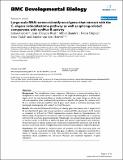| dc.contributor.author | Ceron, Julian | |
| dc.contributor.author | Rual, Jean-François | |
| dc.contributor.author | Chandra, Abha | |
| dc.contributor.author | Dupuy, Denis | |
| dc.contributor.author | Vidal, Marc | |
| dc.contributor.author | van den Heuvel, Sander | |
| dc.date.accessioned | 2011-04-17T05:06:26Z | |
| dc.date.issued | 2007 | |
| dc.identifier.citation | Ceron, Julian, Jean-François Rual, Abha Chandra, Denis Dupuy, Marc Vidal, and Sander van den Heuvel. 2007. Large-scale RNAi screens identify novel genes that interact with the C. elegans retinoblastoma pathway as well as splicing-related components with synMuv B activity. BMC Developmental Biology 7: 30. | en_US |
| dc.identifier.issn | 1471-213X | en_US |
| dc.identifier.uri | http://nrs.harvard.edu/urn-3:HUL.InstRepos:4853390 | |
| dc.description.abstract | Background: The retinoblastoma tumor suppressor (Rb) acts in a conserved pathway that is deregulated in most human cancers. Inactivation of the single Rb-related gene in Caenorhabditis elegans, lin-35, has only limited effects on viability and fertility, yet causes changes in cell-fate and cell-cycle regulation when combined with inactivation of specific other genes. For instance, lin-35 Rb is a synthetic multivulva (synMuv) class B gene, which causes a multivulva phenotype when inactivated simultaneously with a class A or C synMuv gene. Results: We used the ORFeome RNAi library to identify genes that interact with C. elegans lin-35 Rb and identified 57 genes that showed synthetic or enhanced RNAi phenotypes in lin-35 mutants as compared to rrf-3 and eri-1 RNAi hypersensitive mutants. Based on characterizations of a deletion allele, the synthetic lin-35 interactor zfp-2 was found to suppress RNAi and to cooperate with lin-35 Rb in somatic gonad development. Interestingly, ten splicing-related genes were found to function similar to lin-35 Rb, as synMuv B genes that prevent inappropriate vulval induction. Partial inactivation of specific spliceosome components revealed further similarities with lin-35 Rb functions in cell-cycle control, transgene expression and restricted expression of germline granules. Conclusion: We identified an extensive series of candidate lin-35 Rb interacting genes and validated zfp-2 as a novel lin-35 synthetic lethal gene. In addition, we observed a novel role for a subset of splicing components in lin-35 Rb-controlled processes. Our data support novel hypotheses about possibilities for anti-cancer therapies and multilevel regulation of gene expression. | en_US |
| dc.language.iso | en_US | en_US |
| dc.publisher | BioMed Central | en_US |
| dc.relation.isversionof | doi:10.1186/1471-213X-7-30 | en_US |
| dc.relation.hasversion | http://www.ncbi.nlm.nih.gov/pmc/articles/PMC1863419/pdf/ | en_US |
| dash.license | LAA | |
| dc.title | Large-Scale RNAi Screens Identify Novel Genes that Interact with the C. Elegans Retinoblastoma Pathway as well as Splicing-Related Components with synMuv B Activity | en_US |
| dc.type | Journal Article | en_US |
| dc.description.version | Version of Record | en_US |
| dc.relation.journal | BMC Developmental Biology | en_US |
| dash.depositing.author | Vidal, Marc | |
| dc.date.available | 2011-04-17T05:06:26Z | |
| dash.affiliation.other | HMS^Genetics | en_US |
| dc.identifier.doi | 10.1186/1471-213X-7-30 | * |
| dash.contributor.affiliated | Vidal, Marc | |


